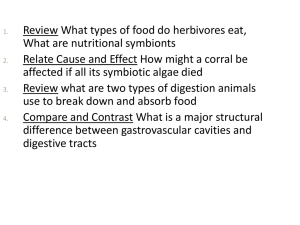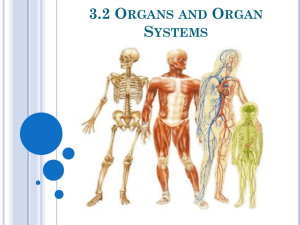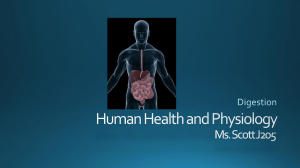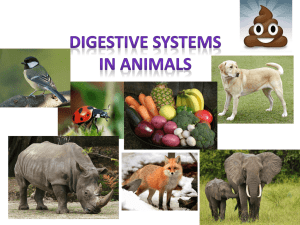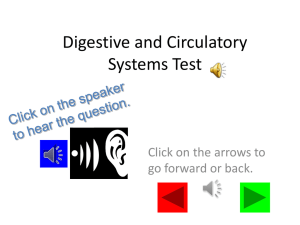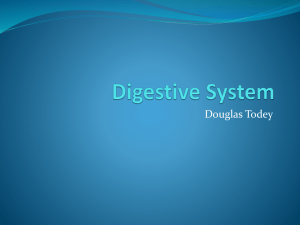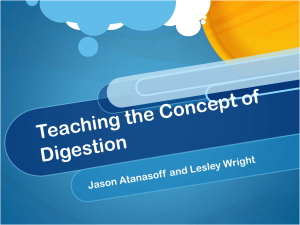GENERAL CHARACTERISTICS OF DIGESTIVE SYSTEM. FEEDING
advertisement
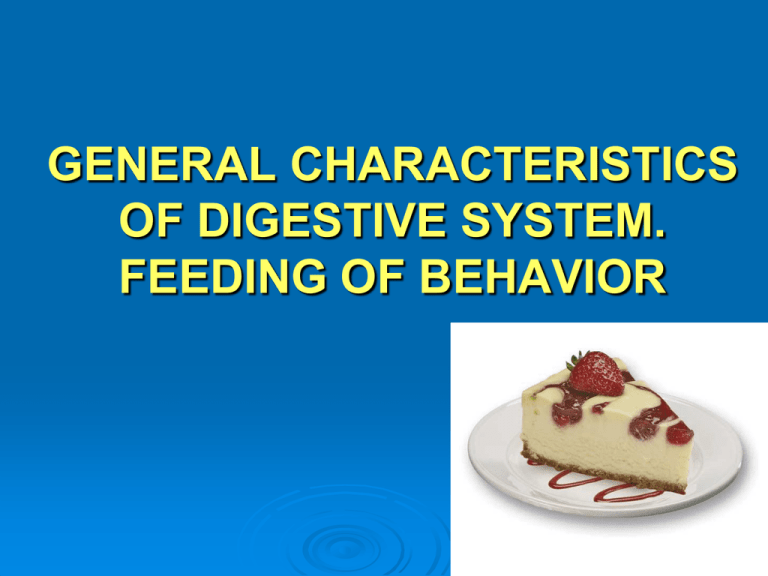
GENERAL CHARACTERISTICS OF DIGESTIVE SYSTEM. FEEDING OF BEHAVIOR Components of the Digestive System Gastrointestinal tract (GI) is a continuous tube that consists of the mouth, pharynx, esophagus, stomach, small intestine, large intestine, and anus. The lumen of this tube is continuous with the external environment. The accessory organs are the salivary glands, exocrine glands, and biliary system (liver and gallbladder). Food Processing Feeding behavior Lack of food Reduction of level of nutrients Excitation chemoreceptors of vessels Feeling of hunger (preventive motivation) Lateral nucleus of the hypothalamus (hunger center) Stimulates appetite Find food (food reaction) Saturation Sensory Stretch receptors of the stomach Ventromedial hypothalamic nuclei (center of saturation) Lateral nuclei of hypothalamus (hunger center) Ventromedial hypothalamic nuclei (center of saturation) Lateral nuclei of hypothalamus (hunger center) Metabolic Chemoreceptors of vessels “The feeding center” Hunger Center - lateral nuclei of the hypothalamus; Center saturation - ventromedial nuclei of the hypothalamus; Brain stem centers that provide chewing, swallowing, salivation, the allocation of digestive juices, motility; Vegetative centers of the spinal cord (lateral horns of segments T1-T4); Limbic system (regulates emotions impact on hunger and satiety, anger, rage - stimulate hunger, longing, sadness inhibit hunger); Cerebral cоrtех are regulates behavioral responses meet of nutritional dominant. Functions of the digestive system Primary: 1. MOTILITY. This refers to the movement of food through the digestive tract through the processes of Ingestion: taking food into the mouth Mastication: chewing the food and mixing it with saliva Deglutition: swallowing food Peristalsis: rhythmic, wavelike contractions that move food through the gastrointestinal tract Functions of the digestive system 2. SECRETION. This includes both exocrine and endocrine secretions. Exocrine secretions: Water, hydrochloric acid, bicarbonate, and many digestive enzymes are secreted into the lumen of the GI tract. The stomach alone, for example, secretes 2 to 3 liters of gastric juice a day. Endocrine secretions: The stomach and small intestine secretes a number of hormones that helps to regulate the digestive system. Functions of the digestive system 3. Digestion. This refers to the breakdown of food molecules into their smaller subunits, which can be absorbed. 4. Absorption. This refers to the passage of digested end products into the blood or lymph. 5. Storage and elimination. This refers to the temporary storage and subsequent elimination of indigestible food molecules. Functions of the digestive system Secondary Homeostatic. Gastrointestinal tract is involved in maintaining the sustainability of water, the concentrations of ions, glucose, amino acids, fatty acids and others. Excretory – expelling certain products of metabolism (e.g. bile pigments), and the salt of heavy metals, from organism. Hemodynamic. venous plexus of the abdominal cavity is played role as depot of blood. Functions of the digestive system Regulatory. GIT is secreted by a numbers of gastrointestinal hormones (GIH) that are participating in the secretory, motor and suction functions of the alimentary canal; Protective. Nonspecific protection is provided by the bactericidal properties of saliva, gastric juice, bile, and antitoxic barrier function of the liver, vomiting. Specific protection is provided in immunoglobulins, which are part of the digestive secrets. Digestion Digestion: is the process of breaking down food into molecules the body can use, the absorption of nutrients, & the elimination of waste. Carbohydrates are broken down to monosaccharides (example: glucose) Proteins are broken down to amino acids Lipids are broken down to fatty acids and glycerol Types of digestion: Mechanical digestion: breaking chunks of food into smaller pieces Chemical digestion: changing food into the subunits listed above by the action of enzymes Types of digestion Classification by localization DIGESTION INTRACELLULAR EXTRACELLULAR Contact Pariental Distal (cavity digestion) Membrane Types of Nutrients Micronutrients- vitamins, minerals, & water Macronutrients- proteins, lipids, carbohydrates, etc… The wall of the digestive tract consists of four layers. The mucosa lines the luminal surface. Its inner epithelial layer has exocrine and endocrine cells. The lamina propria is a middle layer of connective tissue. The muscularis mucosa is a sparse layer of smooth muscle. The submucosa is under the mucosa This connective tissue has large blood and lymph vessels. It contains a submucous plexus. The muscularis externa is the main smooth layer of the digestive tube. It is between the submucosa and outer serosa. The muscularis externa has an inner circular layer and an outer longitudinal layer. Their contractions produce the propulsive and mixing movements. A myenteric plexus is between the two smooth muscle layers. Autonomous smooth muscle function Smooth muscle in GIT shows rhythmic spontaneous variation in it’s resting membrane potential (slow waves). It is also called basic electric rhythm (BER). They do not cause contraction by themselves, but they bring smooth muscle to their thershold and action potentials occur and at that time contraction developed. *** Smooth muscle cells is connected to the adjacent smooth muscle cells by cap junction and electrical activity in one muscle can pass through these cap junction so the whole muscle sheet acts as functional syncytium. This slow cyclic electrical activity is originated from pacemaker cell called Cajal cells which found between circular and longitudinal layers. BER Characteristic of mechanisms regulation digestion Central nervous mechanisms Inconditioned reflexes (inborn) Established when food put in mouth provide such complex reflex acts as chewing, swallowing, vomiting, and regulation of secretion of saliva and gastric and others. juice Conditioned reflexes (depend on experience) Established by smell, by thought food, by talking about food, and even by sounds by its preparation ensure the preparation of the digestive system to eat foods Central nervous mechanisms especially pronounced in the upper part of the alimentary canal, as distance from which their role is reduced. Central Humoral Mechanisms almost no effect on secretion and motility GI tract, but have some effect on the absorption of certain substances (calcium, phosphorus, sodium, etc.).. Methods of studying the functions of the alimentary tract - Experimental methods: Fistula method; X-raying method; Clinical methods: - Method for collecting human saliva by means of the Lashley-Krasnogorsky capsule (small metal funnel); - Electrogastrography; - Х-raying methods; - Endoscopy.
